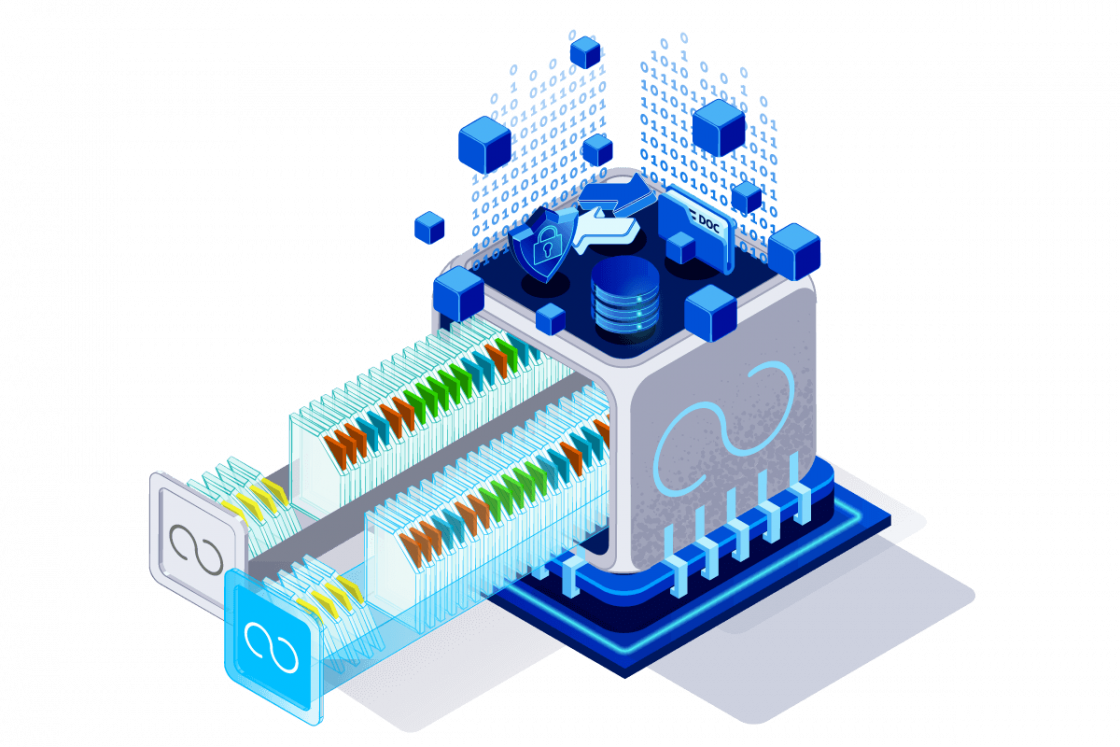What is Data Storage?
Data storage maintains information through specially designed data storage technology that ensures business or personal data is kept safely and remains readily accessible. On-premise data storage involves physical servers or systems located within a company's facility, cloud data storage relies on remote servers, enabling scalability and accessibility from anywhere with an internet connection.

Data Storage Defined
Data storage refers to the process of preserving personal or commercial digital information using various forms of technology. This process involves recording and storing data on different types of media, such as magnetic, optical, or mechanical devices. Even data that a user stores in the cloud is eventually stored on some physical media to read later.
The two main categories of data storage are direct area storage and network-based storage. Direct area storage, also known as direct-attached storage (DAS), is often directly connected to the computing machine and is typically used for local backup services. Sharing network-based storage, on the other hand, allows data to be stored and accessed using software over a sharing network. Either can make use of disks - hard drives - or flash storage, which are memory chips.
Cloud data storage is a specific data storage model where digital data is stored to read on servers maintained by a third-party cloud provider, often just called “the cloud”.
These servers are located in off-site locations, and the provider is responsible for hosting, managing, and securing the personal or corporate data stored on its infrastructure. Cloud storage offers several advantages, including scalability, cost-effectiveness, and the ability to access the cloud data you need from anywhere at any time via the Internet. It also provides a level of data protection, as data is typically encrypted before being transferred over the internet and remains encrypted while stored on the provider's servers.
What are the devices for data storage?
Storage hardware is hosted within an organisation's physical infrastructure and includes servers, computers, and other storage devices all supported by software. One common type of on-premise storage device is a Network Attached Storage (NAS) device. NAS is a file-dedicated storage device that centrally stores and shares data for multiple computers, allowing many authorised users and client devices to access data remotely. Again, a NAS may read from physical disks or indeed memory chips – also known as flash memory.
On-premise storage provides complete control over the data storage hardware and systems. Hardware updates and configurations need the discretion of the business IT staff, to ensure privacy. Moreover, on-premise storage solutions depend on an internally created business sharing network that can be seamlessly accessed offline, making it a reliable solution when fast and stable internet access is not guaranteed.
Cloud storage, on the other hand, uses remote servers and software to save data. The servers are maintained by a third-party business IT provider who is responsible for hosting, managing, and securing data stored on its infrastructure. To maintain availability and provide redundancy, cloud providers often spread data to multiple virtual machines in data centres located across different geographical locations.
Cloud storage providers use a variety of storage devices. Most commercial cloud storage services use vast numbers of hard drives mounted on servers, but flash storage is also used. Service providers have also added high-performance layers to their virtual storage offerings, commonly made up of solid-state drives (SSDs).
Types of data storage
What is file storage?
File storage, also known as file-level or file-based storage, is a hierarchical storage methodology. In this system, data is stored in files, which are organised in folders, and these folders are organised under a hierarchy of directories and subdirectories. To locate a file, the path—from directory to subdirectory to folder to file—is needed.
This type of storage works well with easily organised amounts of structured data and is often used when multiple users or machines need to share files. File storage is accessed using protocols such as Network File System (NFS) for Unix or Linux, or the Server Message Block (SMB) protocol for Microsoft Windows
What is object storage?
Object storage, also known as object-based storage, is a data storage architecture designed to handle large amounts of unstructured data. Unlike file or block storage, it designates data as distinct units, called objects, each bundled with metadata and a unique identifier.
These objects can be stored on-premises or in the cloud. The metadata associated with each object allows for deep business analysis of the use and context of the data. Object storage is often used for storing unstructured data such as photos, videos, machine learning data, sensor data, audio files, and other types of web content. It is the primary storage format for most major cloud service providers
What is block storage?
Block storage, sometimes called block-level storage, is software solutions that control data storage and storage devices. It takes any data, like a file or database entry, and divides it into blocks of equal sizes. Each block is associated with a unique identifier, and the block storage systems then store the data block on underlying physical storage.
Block storage is often used for solutions that require a business to explore efficient, fast, and reliable data access. It is ideal for high-performing, mission-critical applications that require consistent input/output performance and low latency. Block storage can be used as the underlying storage component of a self-managed file storage system, and it is also used in sharing storage area networks (SANs) or cloud-based storage.
Object vs. File vs. Block Storage: How are they different?
Choose file storage when you need to explore a simple, hierarchical storage system that is compatible with traditional file systems and is easy to navigate and manage. It is suitable for smaller data sets and shared access scenarios.
Opt for object storage when dealing with massive amounts of unstructured business data that need to be accessed via web protocols. It is the best choice for cloud-native applications, big data analytics, and archiving due to its scalability and cost-effectiveness.
Finally, block storage for applications that require consistent performance, low latency, and the ability to perform frequent read/write operations. It is ideal for databases and enterprise applications with complex transactional processes.
OVHcloud and Data Storage
One of the key advantages of OVHCloud is its commitment to avoiding vendor lock-in, providing users with more control and flexibility over their data. OVHCloud takes data sovereignty and personal freedom very seriously. We guarantee reversibility, meaning you can recover your data at any time using standard protocols.

OVHCloud offers a comprehensive range of cloud storage solutions to cater to various data storage needs. Our cloud storage for business is designed to provide exceptional performance, security, and data protection, making them ideal for professional cloud storage.
Data Confidentiality
We also commit to respecting data confidentiality. Our cloud infrastructures and services are ISO/IEC 27001, 27017, 27018, and 27701 certified, ensuring that we adhere to international standards for information security management.
That also carries through to a range of other enterprise data compliance standards – including GDPR for companies operating in the EU and HIPAA for companies serving US clients. We even cover local standards such as G-Cloud UK and the Spanish Esquema Nacional de Seguridad (ENS).
*S3 is a registered trademark of Amazon Technologies, Inc. OVHcloud services are not sponsored or approved by, nor affiliated with Amazon Technologies, Inc. in any way.

